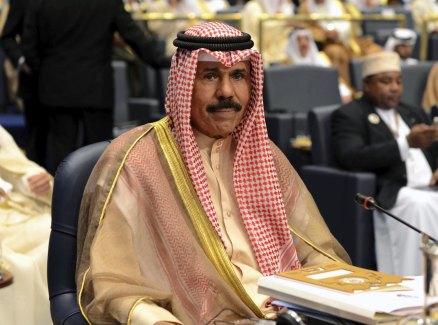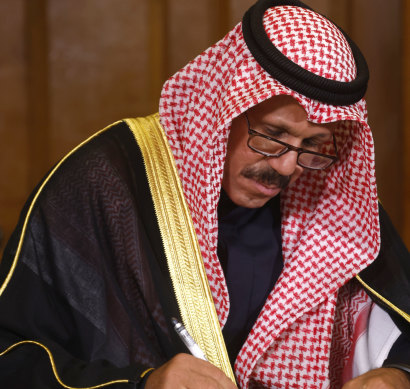This was published 1 year ago
Sheikh Nawaf, Emir of Kuwait, defence minister at Iraqi invasion
THE EMIR OF KUWAIT: 1937 - 2023
Sheikh Nawaf al-Amad al-Sabah, the Emir of Kuwait, who has died aged 86, was minister of defence at the time of the Iraqi invasion in August 1990; he was swiftly demoted after the country was liberated by a coalition led by Britain and the US but was gradually rehabilitated until in 2020 he acceded as ruler, though his reign was blighted by ill health and destined to be the third shortest of any monarch in the history of this tiny, oil-rich country.

Kuwait’s then-Crown Prince Sheikh Nawaf Al-Ahmad Al-Jaber Al-Sabah attends the closing session of the 25th Arab Summit in Bayan Palace in Kuwait City, 2014.Credit: AP
During the seven-month occupation, the Kuwaiti government established its headquarters in the Saudi mountain resort town of Taif, though Nawaf was notably absent. Some reports said he had been injured, others that he had been killed. There were even suggestions that he was hiding in Kuwait, helping to organise the resistance against the Iraqis. According to an Observer report in 1993, however, he had fled the country in a chauffeur-driven Mercedes limousine, leaving the army without orders.
In Kuwait his home, a whitewashed villa with sumptuous bedrooms and a hi-tech kitchen, was one of many buildings to be looted and ransacked. It became the favoured billet of a group of senior Iraqi officers. Liberators found it fortified with sandbags and makeshift sentry boxes on the roof, but the hi-fi, video and other valuables had gone. In the garden lay the rotting carcasses of slaughtered sheep.
This was the least of Nawaf’s problems, however. It was alleged that as Iraqi forces had advanced towards Kuwait, he had given orders for the country’s tanks not to fire on them to avoid provocation. Foreign military experts even claimed that in the days before the invasion Kuwaiti tanks had been pulled back from the border.
Nawaf rejected those charges. “Only 25 to 30 per cent of our real Kuwaiti forces were on hand when the invasion started,” he said in March 1991. “They fought very well and very bravely, but when they ran out of ammunition we ordered them to withdraw to Saudi Arabia.”
Kuwaiti army officers, ranging from captains to colonels, were not satisfied. In a rare intervention they wrote to the then-emir, Sheikh Jaber al-Sabah, criticising Nawaf and Sheikh Salim al-Sabah, the interior minister, and calling for their dismissal. The emir had already accepted the need for change and Nawaf was demoted to minister of social affairs and labour.
In a rare sighting of a Kuwaiti royal squirming before his subjects, Nawaf found himself interrogated by a parliamentary committee, which demanded an explanation of why he and his forces had performed so abysmally. Pressed on why so many officers were on holiday on the day before the invasion, he said it was all “compulsory and urgent leave”, though his case was undermined by reports that his commander-in-chief had fled the country in only his underpants.
The hapless Nawaf became the focus of public ridicule. “Why is Nawaf able to count up to 20 in the summer but only up to 10 in the winter?” ran one joke. Answer: “Because he wears shoes in the winter.”
Redemption was slow. Although he was appointed deputy chief of the country’s National Guard in 1994, it was not until 2003 that he returned to the cabinet as deputy prime minister and minister of the interior. He recovered much of his public esteem when, in January 2005, Kuwaiti security forces successfully saw off a series of attacks by Islamist militants.
In 2006 the new emir, Sabah al-Sabah, named him crown prince and thus de facto heir. At the time it was considered an unusual move, breaking with the tradition that the emir alternates between the al-Jaber and al-Salem branches of the ruling al-Sabah family; like Sabah, Nawaf was an al-Jaber. He served as crown prince for almost 15 years, during which time he was not known for making any major political decisions.

Emir of Kuwait, Sheikh Faisal Nawaf Al-Ahmad Al-Sabah signs a book of condolence at Church House in London, following the death of Queen Elizabeth II, 2022.Credit: PA
Kuwait, a semi-democratic state that is home to 4.2 million people of whom only 1.8 million are Kuwaitis, rode with relative stability the upheavals of the Arab Spring that began in Tunisia at the end of 2010. This did not, however, preclude confrontations between a cabinet dominated by members of the ruling family and the freely elected National Assembly, leading to Sabah dissolving the assembly on at least four occasions.
Sabah died in September 2020 and Nawaf, then aged 83, succeeded him as emir. Immediately he faced an economic crisis caused by the sudden fall in oil prices brought on by the COVID-19 pandemic.
As emir, Nawaf’s most notable move was to pardon and reduce the sentences of nearly three dozen Kuwaiti dissidents who were exiled or in jail. “They call him the ‘emir of pardons’,” Bader al-Saif, from the University of Kuwait, told al Jazeera. “He has led the largest reconciliation in modern Kuwaiti history with a series of amnesties, release of prisoners and citizenships.”
Nawaf al-Amad al-Jaber al-Sabah was born on June 25, 1937, a year before the world’s sixth-largest oil reserves were discovered in Kuwait. He was one of about 28 children of Sheikh Ahmad al-Jaber al-Sabah, who ruled as emir from 1921 until 1950; his mother was Yamama. He was educated at al-Mubarakiya School, though is not thought to have had any university education.
Kuwait achieved independence from Britain in 1961 and the following year the 25-year-old Nawaf became governor of the Hawalli region. He was appointed interior minister in 1978 and became defence minister a decade later.
He is succeeded as emir by his 83-year-old half-brother, Mishal al-Ahmad al-Jaber al-Sabah, a veteran intelligence officer whom Nawaf selected as crown prince in 2020, and who represented the ailing emir at the funeral of Queen Elizabeth II in September 2022.
Nawaf married Sharifa Sulaiman al-Jasem al-Ghanim; they had four sons, the eldest of whom, Ahmad, has been prime minister since July 2022, and a daughter.
The Telegraph, London.